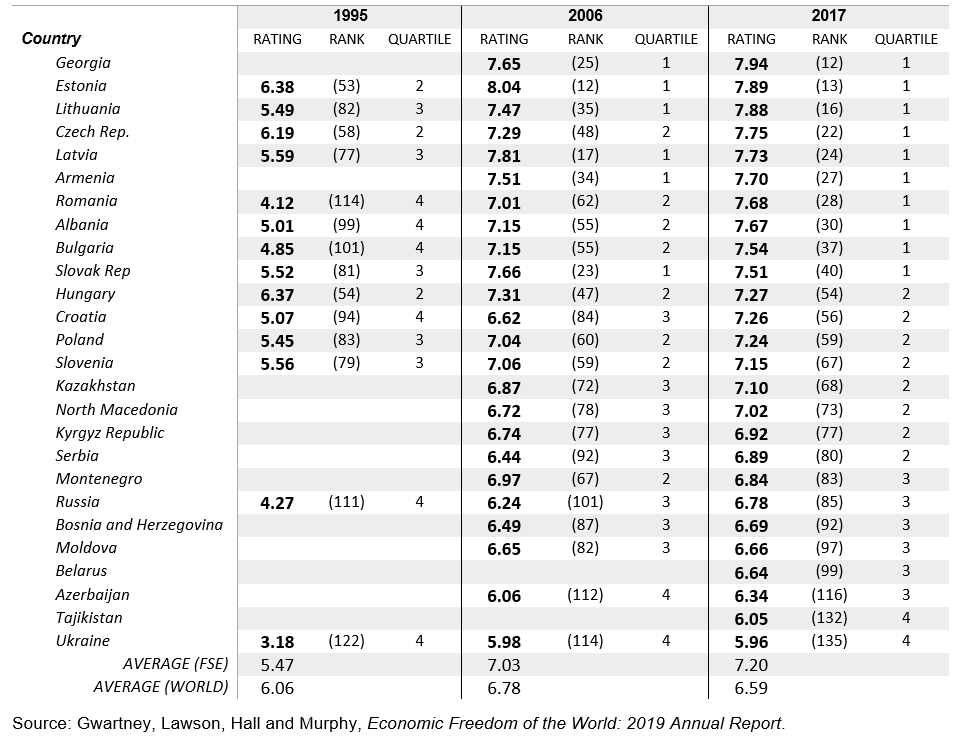The fall of the Berlin Wall on November 9, 1989, was not only the beginning of the reunification of the Germans, it was also one of several events that in the months and years to come would have more than 100 million people, including Estonians, successfully turn their back to communism, steering their economies toward the market.
Prior to the fall of the Iron Curtain, the former socialist economies – to the East of the now infamous barrier dividing Europe – varied considerably in their degree of openness, soundness of their institutions, economic growth and the development process.
Similarly, these countries opted for different paths of market liberalization, some of them moving rapidly and with great strides to reform and liberalize their economies, while others were only undertaking gradual and few transitional steps.
Today, thirty years later, unsurprisingly, public policies and political institutions of the former socialist economies do not equally support economic freedom. However, notably, they support it to a greater extent than they did before the 1990s.
A High Pace of Economic Liberalization
Providing a quantitative assessment of the degree of market liberalism, the Fraser Institute Economic Freedom of the World index displays that the highest levels of economic freedom in Eastern Europe, Caucasus, and Central Asia in 2017, the most recent data available, were in Georgia, Estonia, Lithuania, the Czech Republic, and Latvia, while the lowest levels of economic freedom were in Ukraine, Tajikistan, Azerbaijan, Belarus, and Moldova.
As the data show, all the former socialist economies in Eastern Europe, Caucasus, and Central Asia have strengthened their market features since the fall of the Iron Curtain. This sizable and wide-spread transformation reflects the region’s wholehearted embrace of private property, the rule of law, entrepreneurship, free trade, foreign direct investment, and globalization.
Actually, in the last few decades, economic liberalization has spread across the former socialist region at a higher pace than in the world, with the average degree of market liberalism in the former socialist economies increasing from 5.47 in 1995 to 7.20 in 2017, while the average level of economic freedom in the world went from 6.06 in 1995 to 6.59 in 2017.
The notable transition of the former socialist economies is also reflected in the fact that while in 1995 none of them ranked in the top economic freedom quartile, when in 2017 ten of them (Georgia, Estonia, Lithuania, the Czech Republic, Latvia, Armenia, Romania, Albania, Bulgaria, and the Slovak Republic) were in the top quartile.
By contrast, only two countries (Tajikistan and Ukraine) rank in the fourth quartile of economic freedom, while in 1995, six (Romania, Albania, Bulgaria, Croatia, Tajikistan, and Ukraine) out of fourteen former socialist countries ranked in the fourth quartile.
Continue to Reform and Liberalize
Several of the former socialist economies, such as Georgia and Estonia, have embraced the economic freedom to such an extent and with such a robustness that they have become world-known success stories of market liberalization by way of opening their markets, decreasing barriers to trade, lowering tax burden, stabilizing the monetary system, engaging in deregulation, and strengthening the legal system.
By contrast, other former socialist economies have been reserved to a change, finding it challenging or unwilling to increase their level of economic freedom.
As an example, Hungary observed the smallest move from socialism toward the markets during the 1995-2017 period; however, it still increased the economic freedom score by 0.90.
At a time when nationalism and protectionism are emerging in many countries across the world, which only adds to downward pressure on the global economy, countries in Eastern Europe, Caucasus and Central Asia should draw from their own experience and continue to reform and liberalize their economies, which shall not only have positive impact on economic growth, foreign direct investment, and well-being of the citizens, but will also reduce poverty levels and economic inequalities more successfully than any other economic system.
The article was originally published at: https://estonianworld.com/opinion/three-decades-after-the-fall-of-the-berlin-wall/





